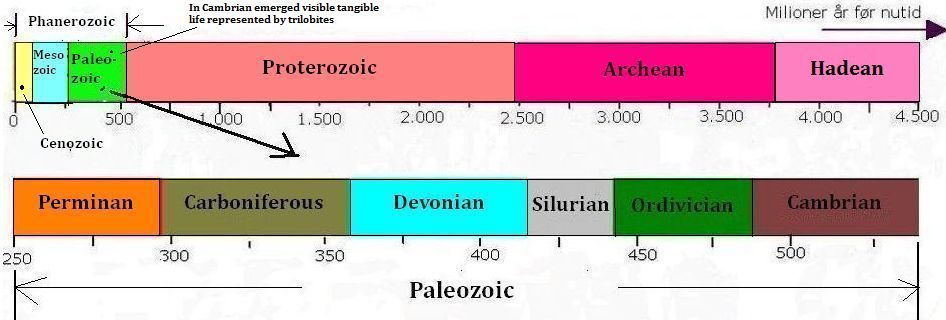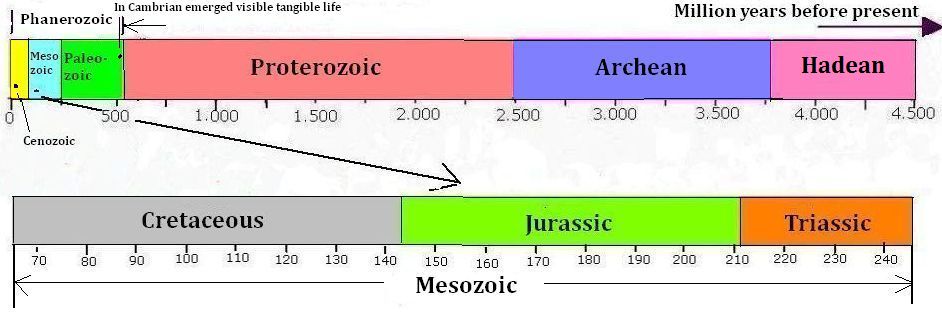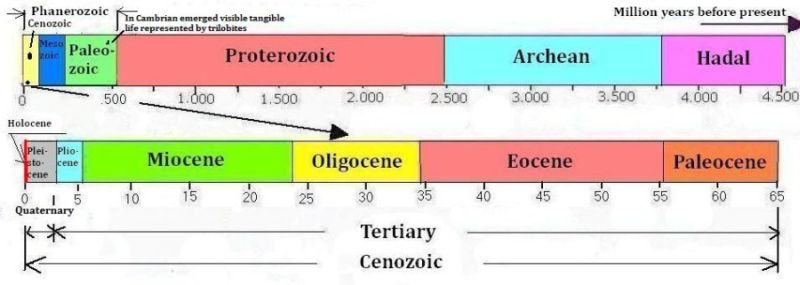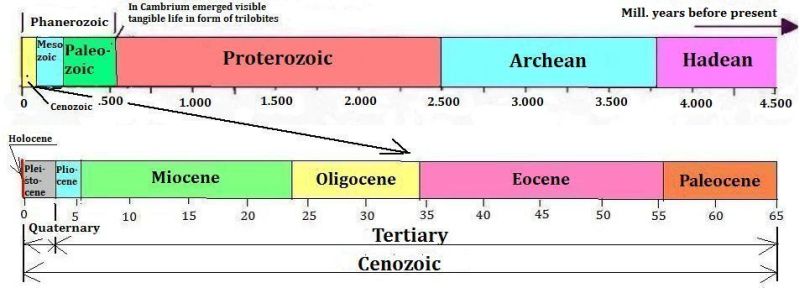to the Holocene Age of Modern Civilizations
To speak to humanity's origins must also be to speak to the conditions of the Earth which allowed the human species to evolve through it's lineages. The history of the Earth's many varied climate changes over the aeons is complex and complexly evolving. Below is a recommended link to investigate in detail each age as listed. They tend to be lengthy because of the detail involved. It is recommended that they are read beyond the introductory paragraph's copied below.
R.E. Slater
June 27, 2023
History of Earth's Climate
1. Precambrian
Introduction
Visible tangible life in the form of trilobites and other animals appeared for the first time in Cambrian. That is why the traditional boundary between the distant geological past and the period of life on Earth, is defined at the start of Cambrian. Cambrian is the first part of Phanerozoic, which traditionally denotes the era, where life has existed on Earth. This article is about the climate during the whole period before Phanerozoic that often is referred to as Precambrian.

The geological eons in Precambrian - Hadean was the burning inferno right after Earth's creation. The first rocks, that we know about, were formed in Archean, water vapor condensed, and an atmosphere of nitrogen and methane was created. Proterozoic was the eon when cyanobacteria produced oxygen, iron and methane were oxidized, and life emerged in the late of the period on the bottom of the sea. Several very severe ice ages occurred in Proterozoic that is the Huronian, Sturtian, Marinoan and Gaskiers ice ages. Phanerozoic denotes the period of life on earth...
---
History of Earth's Climate
2. Paleozoic
1. Introduction
Phanerozoic denotes the part of the Earth's history, where life has been.
Paleozoic is the longest of the Phanerozoic eras. It was the period of early life where plants, corals, mollusks, insects, fish, and many other living organisms emerged. Paleozoic is divided into six geological periods, which are the Cambrian, Ordovician, Silurian, Devonian, Carboniferous and Permian.
It is common to call the widespread explosion of life for the Cambrian explosion. The Cambrian climate is assumed to have been temperate. The Ordovician and Silurian periods had a warm greenhouse climate only interrupted by the Andean-Saharan Ice Age. Devonian and Carboniferous were periods of considerable stability until the Karoo Ice Age at the end of Carboniferous. In Permian dominated a harsh and dry continental climate on the enormous Pangea continent.

Hadean was the glowing inferno just after Earth was formed. In Archean the first rocks, which we know about, were formed, water vapor condensed and an atmosphere of nitrogen and methane came into being. In Proterozoic cyanobacteria produced oxygen that oxidized iron and methane. Also in Proterozoic occurred several very severe Ice Ages that is the Huronian, Sturtian, Marinoan and Gaskiers ice ages. At the end of the period, life emerged on the seabed.
However, the early geologists, who defined and named the geological periods, knew nothing of fossilized bacteria from Archean or the exotic Ediacaran fauna in the late Proterozoic. They had found the fossilized trilobites from the Cambrian, and therefore they believed that it was during that time life emerged on Earth, and therefore it should be marked by the start of a special geological era, which was characterized by life namely Phanerozoic.
Phanerozoic has been divided into Paleozoic, Mesozoic and Cenozoic that we can call Earth's antiquity, medieval and modern times. Paleozoic was the era of early life and is the subject of this article. Mesozoic was the era of the dinosaurs; and Cenozoic is the age of mammals....
---
History of Earth's Climate
3. Mesozoic
1. Introduction
Phanerozoikum is the name of the part of Earth's history where there was visible tangible life. It is divided into Paleozoic, Mesozoic and Cenozoic, which are popularly called the Earth's ancient, medieval and present.
Mesozoic was the period of the dinosaurs. The period is further divided into Triassic, Jurassic and Cretaceous.
Start of Mesozoic with the beginning of Triassic was characterized by the harsh and dry continental climate of the gigantic Pangaea continent. Pangaea's split up in the following Jurassic period paved the way for a hot and humid greenhouse climate with little temperature difference between low and high latitudes. The temperature in Cretaceous was even higher, and most of the world was most likely covered with damp forests.

The surface of the Hadean Earth was a glowing chaos, characterized by intense radioactivity and an atmosphere of toxic gases. In Archean Earth's surface was solidified, the atmosphere consisted of nitrogen and methane, and the first cyano-bacteria occurred. In the Proterozoic methane and iron was oxidized and an atmosphere with oxygen was formed.
Phanerozoic represents the part of Earth's history, where visible tangible life existed, from the appearance of the trilobites in early Cambrian until the emergence of humans and historical time.
The Phanerozoic is divided in Paleozoic, Mesozoic and Cenozoic that can be called Earth's antiquity, medieval and modern times.
Paleozoic was the period of early life where plants, insects, fish, mollusks, corals and many more living organisms developed. Mesozoic was the era of the dinosaurs and is described in this article, and Cenozoic is the age of mammals...
---
 |
| click here to enlarge chart |
History of Earth's Climate
4. Tertiary
1. Introduction
Phanerozoic is the part of Earth's history, where there has been visible tangible life. It is divided into Paleozoic, Mesozoic and Cenozoic, which are popularly called the Earth's antiquity, medieval and present.
Cenozoic is the age of mammals. Tertiary is the name of that part of the age when there were no humans. It is the earliest and longest-lasting part of Cenozoic. Tertiary means the third (age). The five periods of the Tertiary are Paleocene, Eocene, Oligocene, Miocene and Pliocene.

The geological periods - Hadean was the glowing inferno just after the Earth's creation. In Archean the first rocks were formed, an atmosphere of nitrogen, methane was formed and water condensed. In Proterozoic cyanobacteria produced oxygen that oxidized iron and methane, at the end of the period life emerged on the seabed. The entire period prior to Phanerozoic is often called the Precambrian, as it was previously believed that life originated in the Cambrian (earliest period of the Paleozoic) some 500 million years ago.
Phanerozoic - which denotes the period of life on earth - is divided in Paleozoic, Mesozoic and Cenozoic. Paleozoic was the period of early life, when plants, insects, fish, mollusks, corals, and many others living organisms were developed. Mesozoic was the era of the dinosaurs and Cenozoic is the age of mammals, which latter is further divided in Tertiary and Quaternary.
Tertiary denotes that part of the age of mammals when no humans existed. The climate of Tertiary is the subject of this article.
There are more and newer definitions of geological periods adopted at international geological congresses. Some divide the Tertiary into the periods Paleogene and Neogene, others let Quaternary start later in more accurate harmony with human appearance. However, the traditional period-division seems the author most suitable for a popular presentation....
---
5. Pleistocene
Introduction
Phanerozoic is the part of Earth's history, where there has been visible tangible life. It is divided into Paleozoic, Mesozoic and Cenozoic, which are popularly called the Earth's antiquity, medieval and present.
The Cenozoic is the age of the mammals. The part of the Cenozoic, where man has existed is called Quaternary, which means the fourth (age). Quaternary is composed of the periods Pleistocene and Holocene.
However, the Pleistocene lasted 2.6 million years, which is far, far more than the Holocene, which so far has only lasted about 11,000 years. Basically, the Holocene is just another inter-glacial, of which have already been many in the Pleistocene, but it is in this very special inter-glacial that human civilizations have evolved and all of the known history has taken place, and therefore we find this period in the geological and climatic history of Earth immensely important.
But, this article will deal with Pleistocene.
Pleistocene is the period in Earth's history that we commonly refer to as the Ice Age. Through much of this period, the Earth's northern and southern regions were covered by kilometer thick glaciers. It is important to recognize that the Pleistocene was a series of real ice ages, separated by relatively short interglacial periods. The Pleistocene started 2.6 million years ago and lasted until the termination of the Weichsel glaciation about 11,711 years ago.

Timeline of Earth's geological periods. Time progresses from right to left. The glowing inferno just after Earth was formed is named Hadean. In Archean water condensed and an atmosphere of nitrogen and methane was formed together with the first rocks that we know about. In Proterozoic cyano bacteria produced oxygen, which oxidized iron and methane, at the end of the period life emerged on the seabed.
Phanerozoic represents the era in which there has been visible tangible life. It is divided in Paleozoic, Mesozoic and Cenozoic. Paleozoic was the period of early life. Mesozoic was the time of the dinosaurs, and Cenozoic is the era of mammals, which latter further is divided into Tertiary and Quaternary. Tertiary represents the age of mammals and means the third (time). Quaternary means the fourth (time) where not only mammals but also humans existed.
Pleistocene is the first and most part of Quaternary and the subject of this article.
Holocene is marked with red and is slightly visible to the left...
---
6. End of Pleistocene
1. Introduction
Last glacial absolute maximum took place about 26,500 to 19,000 years ago. The ice sheet covered then the whole of Scandinavia and the Baltic region down to North Poland and Germany. In North America, the ice cap extended down to the Great Lakes between Canada and the United States.

Cenozoic is the period of mammals, which followed the Mesozoic which was the period of the dinosaurs. Tertiary is that part of Cenozoic where no humans existed, and Quaternary represents the part of Cenozoic when there were humans. Quaternary is subdivided into Pleistocene and Holocene. Holocene represents the present which basically is a Pleistocene interglacial period. The climate in the last phases of the Pleistocene is the subject of this article...
---
7. Holocene
1. Introduction
If you want to know what the climate was like in the Holocene, simply take some outerwear and go out into nature and look around. Holocene refers namely to the present since the end of the Weichsel glaciation.
The interglacial Holocene has supported the development and growth of human civilizations, it has been the cradle of civilizations, not to say their uterus. It started around 11,700 years before present with a sudden warming from the cold period called Younger Dryas. In only ten years time the temperature in Greenland rose with an impressive 8 degrees, which corresponds to that North Europe's climate was replaced with a Mediterranean climate. It is not known, what caused this rapid rise in temperature.

Cenozoic is the period of the mammals, which followed the Mesozoic that was the period of dinosaurs. Tertiary is that part of Cenozoic, where no humans existed , and Quaternary means the part of Cenozoic, where humans exist. Quaternary is composed of Pleistocene and Holocene. Pleistocene is the period that we in common language call the Ice Age. Holocene represents the present, which basically is a Pleistocene interglacial period. Holocene is represented by the thin red line on the far left. The climate of the Holocene is the subject of this Article.
During the following one thousand years, the temperature increased so that climate became several degrees warmer than today. About 8,000 years before present, in Hunter Stone Age, occurred the hottest period throughout the Holocene. This initiated the warm period called the Holocene Optimum, which lasted almost until about 4,500 years before present, whereafter the temperature continued to drop through bronze age, iron age and historical time until it reached a low point in "The Little Ice Age" in the years 1600- 1700. Within the last few hundred years, the temperature has again increased, but not to such heights as in Hunter Stone Age.











No comments:
Post a Comment